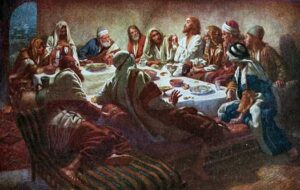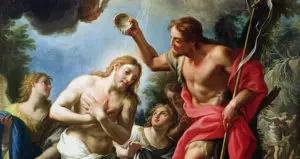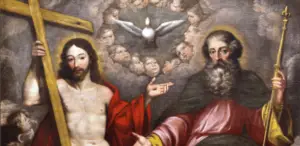Phos Hilaron is regarded as the oldest complete hymn outside of the Bible. The title, which is in Koine Greek, is often translated as “Gladsome Light.”[1] Colloquially, it is known as the “lamp lighting hymn” because it is typically sung during vespers.[2] Since the Byzantine period, saints have performed the hymn employing various translations and melodies. Adaptations by modern artists such as David Crowder[3] and Chris Tomlin[4] have contributed to its continued popularity.
One English translation of the hymn reads:
O Light gladsome of the holy glory of the Immortal Father, the Heavenly, the Holy, the Blessed, O Jesus Christ,
Having come upon the setting of the sun, having seen the light of the evening, we praise the Father, the Son, and the Holy Spirit: God.
Worthy it is at all times to praise Thee in joyful voices, O Son of God, Giver of Life, for which the world glorifies Thee.[5]
Some Christians offer the ancient hymn as evidence of an early belief in the doctrine of the Trinity. In this article, we will explore this perspective to see how it aligns with Church history and the Bible.
An Evening Ritual
A fourth century ritual paints a vivid picture of the song’s meaning. In Jerusalem at that time, a candle was kept burning in a tomb thought to have belonged to Jesus. Each evening, believers would gather at the tomb to have their lamps lit by the candle and to sing Phos Hilaron. The act served as a poignant reminder of the resurrection of Jesus, God’s glorious light.
Even today, when the world seems to be at eventide metaphorically, the promise of the coming resurrection and the return of the Son of God, the Giver of Life (as the last stanza reads), gives rise to joyful hope and praise.

Authorship
The earliest extant record of the hymn appears in the late third or early fourth century in the Apostolic Constitutions, a collection of early Christian writings about ecclesiastical discipline, worship, and doctrine, including material influenced by the Didache. Beginning in book 8.35 of Apostolic Constitutions, in what appears to be a reference to the hymn, the unknown author states that the church should be assembled and after repeating the “psalm at the lighting up of the lights,” the deacon shall offer prayers.[6]
The authorship of the hymn is most often attributed to Athenogenes, a bishop who is said to have composed the song on his way to being martyred by fire. Tradition states the executioner’s arm was supernaturally stayed by paralysis until the song was complete. Basil the Great (ca 330-379 AD), however, in his storied work, De Spiritu Sanctu, said the author was unknown:
“Who was the author of these words of thanksgiving at the lighting of the lamps, we are not able to say.”[7]
Basil then immediately refers to another song, the “hymn Athenogenes,” which he says was “left as a kind of farewell gift to [Athenogenes’] friends” as he was headed to martyrdom.[8] In other words, Basil treats Phos Hilaron and the hymn of Athenogenes as separate works.
Basil’s younger brother, Gregory of Nissa (c. 335-394 AD), also refers to the hymn in a tribute to their sister, Macrina, upon her death:
Meanwhile evening had come, and a lamp was brought in. All at once she opened the orb of her eyes and looked towards the light, clearly wanting to repeat the thanksgiving sung at the Lighting of the Lamps. But her voice failed, and she fulfilled her intention in the heart and by moving her hands, while her lips stirred in sympathy with her inward desire. But when she had finished the thanksgiving, and her hand brought to her face to make the Sign had signified the end of the prayer, she drew a great deep breath and closed her life and her prayer together.[9] (emphasis added)

Evidence of the Trinity?
The authorship of Phos Hilaron is not the only mystery associated with this hymn. Some Trinitarians claim the second stanza contains evidence of the mysterious doctrine of the triune God:[10]
Having come upon the setting of the sun, having seen the light of the evening, we praise the Father, the Son, and the Holy Spirit: God.
Basil’s description of the hymn as being “ancient” is said to give further credence to the Trinitarian’s position:
The people, however, utter the ancient form, and no one has ever reckoned guilty of impiety those who say, ‘We praise Father, Son, and God’s Holy Spirit.’ [11]
Basil, in contrast to the original lyric which refers to Father, Son, and Holy Spirit as God, lists the Holy Spirit as God’s Holy Spirit, that is, the Spirit of God. This suggests something less than a tripersonal God. Nevertheless, to determine if the original lyric suggests that the song’s author believed in a tripersonal God or if it provides evidence for Trinitarian belief in the early Church, it is necessary to understand the doctrine of the Trinity.
Doctrine of the Trinity
The doctrine of the Trinity states that God exists as one being in three distinct persons: Father, Son, and Holy Spirit. Each person is fully God, co-equal, co-eternal (uncreated), and con-substantial (of the same essence).
Although there are Scriptural passages that speak of Father, Son, and Holy Spirit, there is no mention or teaching of a shared equality, eternality, or substance. The Oxford Companion to the Bible says:
While there are other New Testament texts where God, Jesus, and the Spirit are referred to in the same passage, it is important to avoid reading the Trinity into places where it does not appear.[12]
Similarly, although the song’s lyric speaks of Father, Son, and Holy Spirit, it does not address the relationship between the three. It does not convey in what sense each is God, nor does it address any sense of a shared equality, eternality, or substance between the three. Indeed, the only person declared to be eternal in the hymn is the “Immortal Father.” In this instance, we must likewise be careful not to read into the lyric the doctrine of the Trinity.
What Did First Century Christians Believe?
We can learn what the first century Christians believed about God by reading the Bible. Nowhere does it speak of Father, Son, and Holy Spirit as being the one God. It never teaches that the three are co-equal, co-eternal, or consubstantial. It does, however, clearly state that the one God is the Father alone. For example, Jesus said,
John 17:1-3 (NASB) “…Father, the hour has come; glorify Your Son, so that the Son may glorify You, 2 just as You gave Him authority over all mankind, so that to all whom You have given Him, He may give eternal life. 3And this is eternal life, that they may know You, the only true God, and Jesus Christ whom You have sent. (emphasis added)

Just as Jesus acknowledged that the Father was the only true God, he identified himself as the Christ, that is, not God but the anointed of God.
Paul shared the same theology. He believed the Father is the one God, and Jesus is the human Christ:
1 Corinthians 8:5-6 (NASB) For even if there are so-called gods whether in heaven or on earth, as indeed there are many gods and many lords, 6yet for us there is only one God, the Father, from whom are all things, and we exist for Him; and one Lord, Jesus Christ, by whom are all things, and we exist through Him. (emphasis added)
1 Timothy 2:5 (NASB) For there is one God, and one mediator also between God and men, the man Christ Jesus (emphasis added)
Peter, likewise, joins the theological chorus. On the Day of Pentecost, which is considered to be the birth of the Church, Peter stood up and preached:
Acts 2:22-23, 36 (NASB) “Men of Israel, listen to these words: Jesus the Nazarene, a Man attested to you by God with miracles and wonders and signs which God performed through Him in your midst, just as you yourselves know— 23 this Man, delivered over by the predetermined plan and foreknowledge of God, you nailed to a cross by the hands of godless men and put Him to death….36 Therefore let all the house of Israel know for certain that God has made Him both Lord and Christ—this Jesus whom you crucified.” (emphasis added)
If there was ever a time to declare that the one God of the Old Covenant was actually a three-in-one being, the inauguration of the New Covenant would have been it! But Peter never teaches a tri-part God. Instead, for the fisherman-turned-apostle, Jesus was a human through whom God worked. What’s more, God exalted this Jesus of Nazareth to be both Lord and Christ.
What Trinitarian Scholars Say
Trinitarian scholars admit the doctrine of the Trinity is not taught in Scripture. Theologian Charles Ryrie, for example, writes in his respected work, Basic Theology:
It is fair to say that the Bible does not clearly teach the doctrine of the Trinity… In fact, there is not even one proof text, if by proof text we mean a verse or passage that ‘clearly’ states that there is one God who exists in three persons.[13] (emphasis added)
Ryrie is not alone. C. Peter Wagner, author and former professor at Fuller Theological Seminary writes:
Nevertheless, there is no appearance of the word Trinity in the Bible, nor is there any single passage that describes God as three Persons in one essence. That is why it took hundreds of years of debate to arrive at our trinitarian doctrinal conclusion. It obviously had to be the result of extrabiblical revelation.[14] (emphasis added)

To be sure, the doctrine of the Trinity was not a part of first century Church dogma, but rather, it slowly developed over three hundred years. Pinchas Lapide, an Israeli historian and theologian specializing in the New Testament, offers this insightful observation about the development of the dogma:
Whoever knows the development of the history of dogma knows that the image of God in the primitive Church was a unitarian one. Only in the second century did it gradually, against the doctrine of subordinationism, become binary. For the church fathers, such as Justin Martyr, Irenaeus, and Tertullian, Jesus is subordinated to the Father in everything, and Origen hesitated to still direct his prayers to Christ, for as he wrote, that should properly be to the Father alone. At this point, he referred to the words of Jesus in the Gospel of John: “The Father who has sent me is greater than I.”
The total picture which arises from history is almost like an arithmetic progression: In the first century, God is still monotheistic in good Jewish fashion. In the second century, God becomes two in one; from the third century on, God gradually becomes threefold. Only in the fourth century does the elevation of the Holy Spirit with a special hypostasis with its own value take place.[15] (emphasis added)
How, then, did the earliest teaching about the Father being the only true God evolve to include the Son and the Spirit? Church historian Philip Schaff writes that the doctrines of the early Church were altered when Christianity spread throughout the Greco-Roman world:
“…many of the early Christians, in turn, found peculiar attractions in the doctrines of Plato and employed them as weapons for the defense and extension of Christianity, or cast the truths of Christianity in a Platonic mold. The doctrines of the Logos and the Trinity received their shape from Greek Fathers, who…were much influenced, directly or indirectly, by the Platonic philosophy, particularly in its Jewish-Alexandrian form. That errors and corruptions crept into the Church from this source cannot be denied.”[16] (emphasis added)
The historical progression of dogma can also be seen in Church creeds. For example, the unitarian God of the Bible is seen in both the Old Roman Creed of the second century and the Apostles’ Creed of the third century. It is not until the fifth to sixth century that we see the fully evolved Trinitarian God, which includes a dual-natured Jesus, in the Athanasian Creed.
Conclusion
It is impossible to know the theological position of the Phos Hilaron author as he does not elaborate on the relationship between Father, Son, and Holy Spirit. Was he a Trinitarian in today’s sense of the word? It is unlikely since the doctrine did not fully evolve until the First Council of Constantinople (381 AD), long after the song was thought to have been written. Was the author a subordinationist like Tertullian, who, even though he believed in the Father, Son, and Holy Spirit and used the word trinitas to describe them, did not believe in the doctrine of the Trinity as it is understood today?[17] It is possible since the author describes only the Father as being immortal. But, again, we cannot know.
Conversely, it can be understood that Phos Hilaron, rather than serving as evidence of a doctrinal belief in the Trinity in the early church, more accurately reflects a transition from the unitarian perspective of the first century towards an evolving concept of a tri-personal God. As one Trinitarian author acknowledges, Phos Hilaron is an example of the Church’s changing view of God:
The inclusion of all three persons of the Trinity in this hymn reflects the Church’s developing understanding of God as a triune being, a belief that would later be formalized in the Nicene Creed.”[18] (emphasis added)
Rather than using an undated hymn, despite its beauty, as evidence for a Trinitarian God, it is best to rely on Scripture’s definition of God. There, we find the authoratative earliest and most credible testimony of God as being the Father alone.
[1] According to Strong’s Lexicon 5457, phos in Greek means light, while hilaron 2431 means cheerful. The phrase is often translated as gladsome light, joyous light, gladdening light, etc.
[2] Vespers or evening prayers. Vespers comes from the Latin word “vespera,” which means evening.
[3] David Crowder, Phos Hilaron, Hail Gladening Light
[4] Chris Tomlin, Joyous Light
[5] This translation is said to be a verbatim translation of Phos Hilaron, Wikipedia, accessed 03-36-25.
[6] Apostolic Constitutions, Book 8, New Advent
[7] De Spiritu Sanctu, chapter 29.73.
[8] Ibid.
[9] W.K. Lowther Clarke, Gregory of Nissa: Life of Saint Macrina, London, 1916, p.57.
[10] The Catechism of the Catholic Church purports, “The mystery of the Most Holy Trinity is the central mystery of Christian faith and life” (CCC 234).
[11] Basil the Great, De Spiritu Sanctu, chapter 29.73.
[12] Daniel N. Schowalter, Oxford Companion to the Bible, ed. Bruce M. Metzger, Michael D. Coogan, Oxford University Press, 1993, pg 782-783.
[13]Charles C. Ryrie, Basic Theology: A Popular Systematic Guide to Understanding Biblical Truth, (Chicago, IL: Moody Publishers, 1999), p. 89.
[14] C. Peter Wagner, “But That’s Not in the Word!” Charisma Magazine, June 2014, accessed 04-13-19,
[15] Pinchas Lapide, Jewish Monotheism and Christian Trinitarian Doctrine: A Dialogue by Pinchas Lapide and Jurgen Moltmann, (Philadelphia: Fortress Press), 1981, p.39.
[16] Philip Schaff “Platonism and Christianity” in The New Schaff-Herzog Encyclopedia of Religious Knowledge, Vol IX.
[17] In Praxeas 7 and 9, Tertullian writes that the Father is greater than the Son because of his origin and substance; the two are not equal. Moreover, in Praxeas 3, he writes that the majority of believers were startled by his view of God because it did not comport with the only one God of Scripture, i.e., their unitarian view of God.
[18] Douglas C. Youvan, Voices from Antiquity: A Study of the Oldest Christian Hymns and Their Enduring Legacy.



